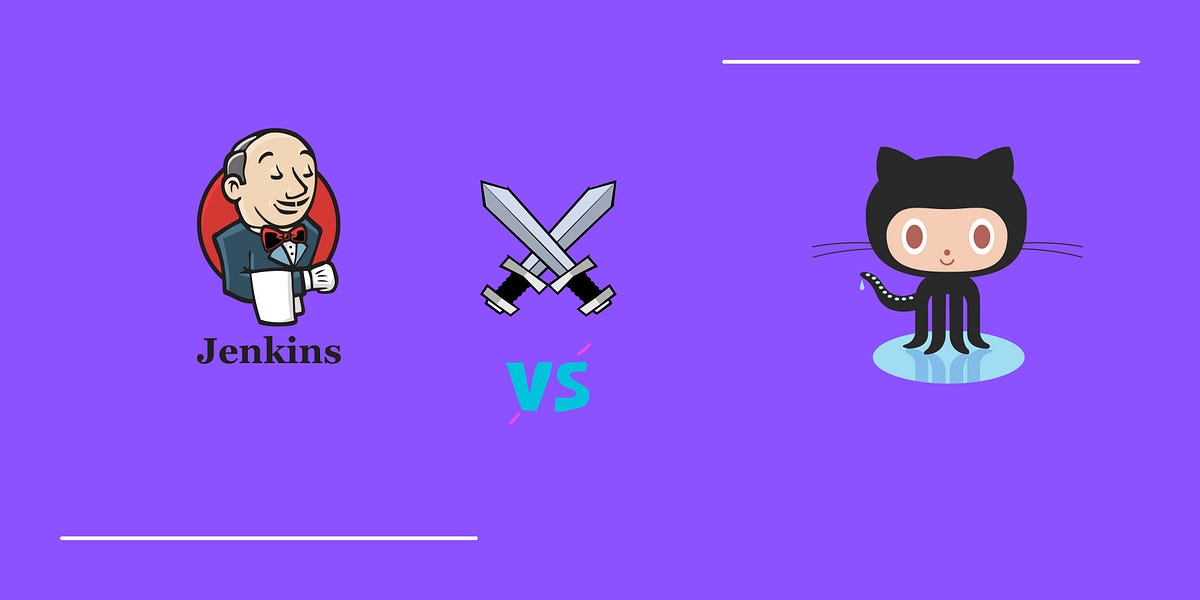GitHub Actions vs Jenkins: Simplifying Your CI/CD Pipeline
Choosing the Right CI/CD Tool for Your Project
Understanding CI/CD: The DevOps Backbone
Before we pit Jenkins against GitHub Actions, let's establish a common ground. CI/CD is the lifeblood of modern DevOps, streamlining the software development process. Continuous Integration (CI) involves automatically merging code changes into a central repository, while Continuous Delivery (CD) automates the release process, allowing for faster and more frequent deployments. Imagine a well-oiled machine, where code integration and deployment are seamless and efficient – that's the power of CI/CD. Without CI/CD, development cycles can become incredibly sluggish and error-prone. The efficiency gains are immense.
Effective CI/CD pipelines are essential for reducing the risk of integration issues, improving code quality, and accelerating time to market. They're not just a convenience; they're a necessity in today's fast-paced software development landscape. Consider the impact on a large team working on a complex project—the benefits become readily apparent. The ability to frequently merge and test code drastically reduces the likelihood of major integration problems emerging only during later stages. This translates into significant cost and time savings.
Jenkins: The Veteran CI/CD Maestro
Jenkins, a long-standing stalwart in the CI/CD arena, has earned its reputation as a robust and versatile tool. Its open-source nature and extensive plugin ecosystem allow for unparalleled flexibility and customization. With Jenkins, you can tailor your CI/CD pipelines to fit virtually any requirement. Imagine a complex project with a unique deployment process; Jenkins allows you to craft a pipeline that precisely matches it. This adaptability is a key strength.
Jenkins's plugin architecture lets you integrate with almost any tool or service imaginable, providing a level of integration that's difficult to match. But this very strength can also be a weakness. The abundance of plugins can lead to complexity, making it potentially overwhelming for new users. The learning curve can be quite steep for those unfamiliar with Jenkins's intricate configurations. Careful planning and a structured approach are needed to leverage its full power effectively. A poorly configured Jenkins pipeline could quickly become a source of frustration.
Jenkins Strengths: Flexibility and Extensibility
Jenkins’s core strength is its flexibility. It can be molded to meet virtually any CI/CD need due to its vast plugin ecosystem. This adaptability is crucial for complex projects with unique deployment requirements. You can use plugins to integrate with various tools, customize workflows, and even create entirely unique automation solutions. For instance, a project might require specific testing frameworks or deployment procedures that aren't directly supported out of the box. Jenkins plugins make these integrations seamless.
This extensibility further allows for advanced customization of workflows. You can build intricate pipelines with conditional steps, parallel processing, and advanced error handling. This granular control gives DevOps engineers the power to fine-tune the CI/CD process to maximize efficiency and reliability. Think about a situation where only certain code changes should trigger deployment. Jenkins’s advanced features facilitate this level of precision in automation.
Jenkins Challenges: Complexity and Steep Learning Curve
Jenkins's extensive configurability, while a strength, can also become a hurdle. The sheer number of plugins and options can be overwhelming, especially for new users. Setting up and maintaining a Jenkins server requires technical expertise and a solid understanding of its architecture. Misconfigurations can lead to pipeline failures and instability. For smaller teams or those without dedicated DevOps engineers, the management overhead can be significant.
The learning curve for Jenkins can be quite steep. Mastering its various configurations, plugins, and scripting options takes time and effort. There is a significant investment required in terms of training and experience to utilize its advanced functionalities effectively. The documentation, while extensive, can be daunting for beginners. Therefore, robust training and experienced mentors are invaluable assets in any Jenkins-based CI/CD setup.
Looking to excel in the world of DevOps? Enroll in the Apnaguru Fullstack DevOps Course today and master cutting-edge tools like Jenkins and GitHub Actions.
GitHub Actions: The Agile and Integrated Contender
GitHub Actions, a more recent player in the CI/CD arena, offers a simpler and more integrated approach. Directly integrated into GitHub, it provides a streamlined workflow for automating your software development lifecycle. Its ease of use and intuitive interface make it a popular choice for developers and smaller teams. Its simplicity is a considerable advantage over the complexity of Jenkins.
The seamless integration with GitHub is a significant advantage. GitHub Actions leverages GitHub's existing features, allowing for smooth integration with version control, issue tracking, and code reviews. This streamlined approach reduces the complexity often associated with setting up and maintaining CI/CD pipelines. Consider the time saved by having your CI/CD process integrated directly with your version control—it's a significant productivity booster. This ease of access reduces the barriers to entry for adopting CI/CD.
GitHub Actions Advantages: Seamless GitHub Integration and Simplicity
The primary benefit of GitHub Actions is its ease of use and tight integration with the GitHub platform. This eliminates the overhead of setting up and managing a separate CI/CD server. Its intuitive interface allows developers to quickly define and configure workflows without needing extensive DevOps expertise. Workflows are defined using YAML files, making them easy to read, understand, and manage. This contrasts sharply with Jenkins's more complex configuration.
The direct integration with GitHub's ecosystem simplifies various aspects of the software development process. For instance, triggering workflows based on code pushes, pull requests, or issue creation is seamless and straightforward. This tightly coupled approach streamlines the development workflow, resulting in increased efficiency. Such close ties ensure the pipeline is always aware of the current state of your project in GitHub, triggering builds and tests at the optimal moments.
GitHub Actions Limitations: Ecosystem and Customization
While GitHub Actions excels in simplicity and integration, its ecosystem is relatively smaller compared to Jenkins's extensive plugin library. This means that the range of tools and services it integrates with is more limited. If your project requires integration with less common tools, you might find yourself limited by the available actions. This can be a significant constraint for projects with very specific or specialized requirements.
Customization options in GitHub Actions are also more limited than in Jenkins. While you can achieve a high degree of automation, the flexibility to create complex, highly customized workflows is somewhat restricted. This can pose challenges for complex projects needing highly specific CI/CD configurations. For simple projects with standard workflows, this isn't a major concern, but for complex projects, it might require workarounds or alternative solutions.
Looking to excel in the world of DevOps? Enroll in the Apnaguru Fullstack DevOps Course today and master cutting-edge tools like Jenkins and GitHub Actions.

Head-to-Head Showdown: Jenkins vs. GitHub Actions
Let's compare Jenkins and GitHub Actions directly. The table below summarizes key features and differences. Remember that the “best” choice depends heavily on your project’s specific needs and your team’s expertise.
Feature Comparison: A Detailed Breakdown
This section provides a more detailed examination of specific features. We delve deeper into areas such as ease of use, scalability, cost considerations, and the strength of the community support each platform offers. Ease of use is particularly important for new users or smaller teams, while scalability is crucial for larger, more complex projects.
Cost is always a factor to consider. While Jenkins is open-source, there are associated costs for hosting and maintenance. GitHub Actions’ pricing model is based on usage, so the costs depend on the number and complexity of workflows. Community support is another important element to consider, as a robust and active community means quicker problem resolution and easier access to knowledge.
Use Case Scenarios: Choosing the Right Tool
The ideal choice between Jenkins and GitHub Actions depends largely on your project's specific circumstances. For simple projects with straightforward workflows and a need for seamless GitHub integration, GitHub Actions is generally the better option due to its ease of use and intuitive interface. Its integration with GitHub's features streamlines the development process significantly.
However, for complex projects requiring extensive customization, advanced features, or integration with a wide array of tools and services, Jenkins's flexibility and vast plugin ecosystem make it a more suitable choice. Its ability to handle intricate workflows and integrate with diverse systems is unmatched. Ultimately, the decision rests on balancing the need for simplicity versus the requirement for flexibility and extensibility.
Making the Right Choice: Factors to Consider
Several factors influence the decision between Jenkins and GitHub Actions. Let's consider these crucial aspects:
Project Size and Complexity
For small, simple projects, GitHub Actions offers a streamlined and easy-to-use solution. Its seamless integration with GitHub makes it ideal for smaller teams. However, as project complexity increases, Jenkins's flexibility and extensibility become more valuable. Large, intricate projects with unique deployment needs will benefit from Jenkins’s advanced features.
The scalability of each platform is a significant factor. GitHub Actions is well-suited for projects of moderate size and complexity. However, for projects that require extremely high scalability and the ability to handle a large number of concurrent workflows, Jenkins’s robust infrastructure and extensive configuration options are advantageous.
Team Expertise and Preferences
The technical expertise of your team plays a crucial role in this decision. GitHub Actions' simplicity makes it accessible to teams with limited DevOps experience. Its user-friendly interface and straightforward configuration make it easier to learn and use. Conversely, Jenkins requires a deeper understanding of CI/CD concepts and its plugin system. Teams with significant DevOps expertise can effectively leverage Jenkins's power.
Team preferences also factor into this decision. If the team is already comfortable with GitHub’s workflow, GitHub Actions is a natural extension. However, if the team prefers the flexibility and control offered by a more extensive and customizable platform, Jenkins might be a better fit. Ultimately, the decision should align with the team's existing skills and preferences.
Integration with Existing Tools
Consider how well each platform integrates with your existing development tools and infrastructure. GitHub Actions' tight integration with GitHub is a major advantage if you already use GitHub extensively. However, Jenkins's extensive plugin ecosystem provides a much wider range of integrations. If your project relies on tools not directly supported by GitHub Actions, Jenkins’s flexibility might be essential.
Evaluate the compatibility of your existing infrastructure and tools with each CI/CD solution. Ensuring seamless integration prevents workflow disruptions and optimizes efficiency. Proper assessment of compatibility ensures a smooth transition and prevents potential conflicts or unexpected limitations during the implementation of the CI/CD pipeline.
Budget and Resource Constraints
Jenkins, being open-source, has lower initial costs. However, there are ongoing costs associated with hosting and maintaining the Jenkins server. GitHub Actions' pricing model is based on usage, which can be advantageous for smaller projects with limited resources. This pay-as-you-go approach makes it a cost-effective solution for projects with fluctuating demands.
Consider the long-term cost implications of each choice, including infrastructure, maintenance, and personnel costs. Compare the total cost of ownership (TCO) for both options. Factor in potential costs for training, support, and specialized expertise needed for either platform. A thorough cost-benefit analysis will ensure a financially responsible decision.
Unlocking DevOps Mastery: Apnaguru Full Stack DevOps Course
Want to become a DevOps master? Apnaguru's Full Stack DevOps course is your key to unlocking expertise in CI/CD and beyond! Learn to build, deploy, and manage complex systems with confidence. Gain in-demand skills and elevate your career to new heights. This course will empower you to confidently tackle any CI/CD challenge using Jenkins, GitHub Actions, or any other tool in your DevOps arsenal! Enroll today and transform your career.
Apnaguru's comprehensive course covers a vast range of topics, including cloud computing, containerization, infrastructure as code, and more. You will learn to efficiently automate your workflows and master the intricacies of CI/CD. This program is designed to prepare you for a successful career in the rapidly growing field of DevOps. Don’t miss this opportunity to enhance your skills and career prospects.
Review
Kalpesh Shewale
I am grateful to have completed my Full Stack Development with AI course at Apnaguru. The faculty's support and interactive classes helped me discover my potential and shape a positive future. Their guidance led to my successful placement, and I highly recommend this institute.
Kalpesh Shewale
I am grateful to have completed the Full Stack Development with AI course at Apnaguru. The faculty's dedicated support and hands-on approach during the classes enabled me to unlock my potential and shape a promising future. Their guidance helped me secure a placement with a good package. I highly recommend this course, and for those interested, I also suggest doing the offline version at the center for an enhanced learning experience.

Raveesh Rajput
Completing the Full Stack Development with AI course at Apnaguru was a game-changer for me. I secured an internship through this course, which gave me invaluable hands-on experience. I strongly recommend this course to anyone looking to break into the tech industry. For the best experience, I suggest attending the offline sessions at the center, where the interactive learning environment really enhances the overall experience.

swapnil shinde
Apnaguru’s Full Stack Development with AI course provided me with more than just knowledge—it opened doors to an internship that gave me real-world, hands-on experience. If you're serious about a career in tech, this course is a must. I highly recommend attending the offline sessions for the most immersive and interactive learning experience!
Kalpana Waghmare
I recently completed the Full Stack Developer with AI course on ApnaGuru, and I couldn’t be more impressed! The structure of the course, with well-organized topics and self-assessment MCQs after each section, really helped reinforce my learning. The assignments were particularly valuable, allowing me to apply what I learned in a practical way. Overall, it’s an excellent program that effectively combines full-stack development and AI concepts. Highly recommended for anyone looking to enhance their skills!
Completing the Full Stack Development with AI course at Apnaguru was a pivotal moment in my career. It not only deepened my understanding of cutting-edge technologies but also directly led to an internship that provided practical, real-world experience. If you're aiming to enter the tech field, this course is an excellent stepping stone. I especially recommend attending the in-person sessions at the center, where the dynamic, hands-on learning approach truly maximizes the benefits of the program.

Mahesh Bhosle
I completed the Full Stack Development course at Apnaguru, and it was a valuable experience. The focus on live assignments and projects gave me real-world insights, helping me apply my skills in a professional setting. The interactive live sessions, mock interviews, and question banks were excellent for job preparation. Apnaguru’s company-like environment also helped me get accustomed to real work dynamics. Overall, this course equipped me with the skills and confidence needed for a career in full-stack development. I highly recommend it to anyone seeking hands-on learning and industry relevance.
I recently completed the Full Stack course at ApnaGuru, and I’m genuinely impressed! The curriculum is well-structured, covering both front-end and back-end technologies comprehensively. The instructors are knowledgeable and provide hands-on experience through practical projects. The supportive community and resources available made learning enjoyable and engaging. Overall, it’s a great choice for anyone looking to kickstart a career in web development. Highly recommend!

Adarsh Ovhal
I recently participated in the Full Stack Development With AI Course program, and it has been incredibly beneficial. The guidance I received was tailored to my individual needs, thanks to their advanced use of AI tools. The Trainers were knowledgeable and supportive, helping me explore various educational and career paths. The resources and workshops provided were practical and insightful, making my decision-making process much clearer. Overall, I highly recommend this program to any student looking for IT Field and personalized career guidance!
Shirish Panchal
I’m currently pursuing the Full Stack Developer with AI course at ApnaGuru Training Center, and I'm impressed with what I've experienced so far. The curriculum is well-structured, covering key concepts in both front-end and back-end development, along with AI fundamentals. The instructors are knowledgeable and supportive, which makes it easy to engage and ask questions. I particularly appreciate the hands-on projects that help reinforce what I’m learning. While I’m still in the process of completing the course, I feel that I'm building a strong foundation for my future in tech. I would recommend ApnaGuru to anyone looking to explore full stack development with AI!
Apnaguru Training Center stands out as a top-notch institute for IT education. They provide a wide array of courses, including Full Stack Development, Java Full Stack, Python, Automation Testing, DevOps, and MERN/MEAN Stack, all designed to meet the demands of the modern tech industry.

Mahesh Bhosle
Apnaguru Training Center is a fantastic place for IT education! They offer a variety of courses, including Full Stack Development, Java Full Stack, and Python, all taught by knowledgeable instructors who are committed to student success. The curriculum is up-to-date and includes hands-on projects that enhance learning.
dandewar srikanth
I had an excellent experience with the full-stack web development program at APNAGURU. The instructor had in-depth knowledge of both frontend and backend technologies, which made the concepts easy to grasp. From working on HTML, CSS, JavaScript, and React for the frontend to Node.js and MongoDB for the backend, the learning curve was very smooth.